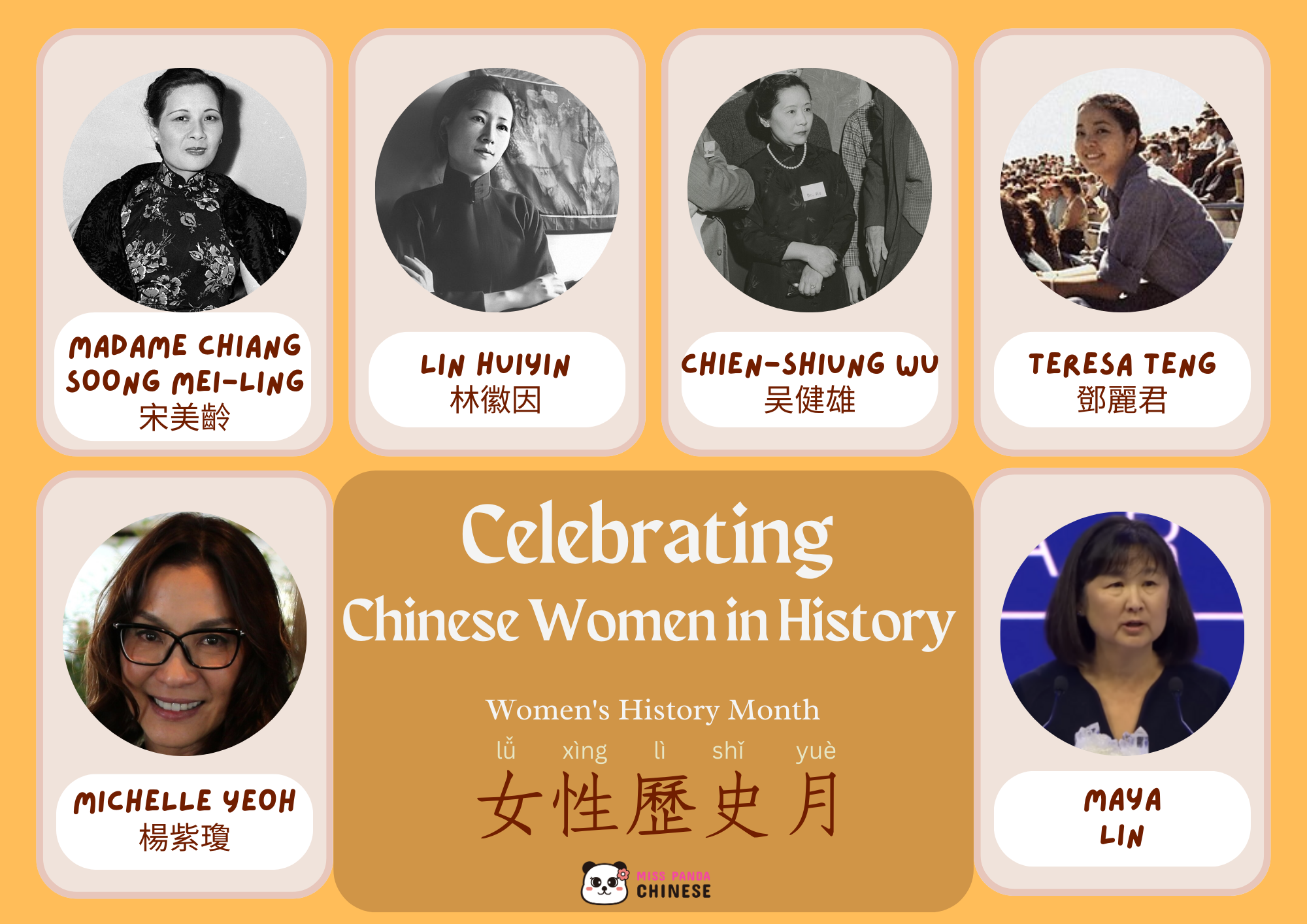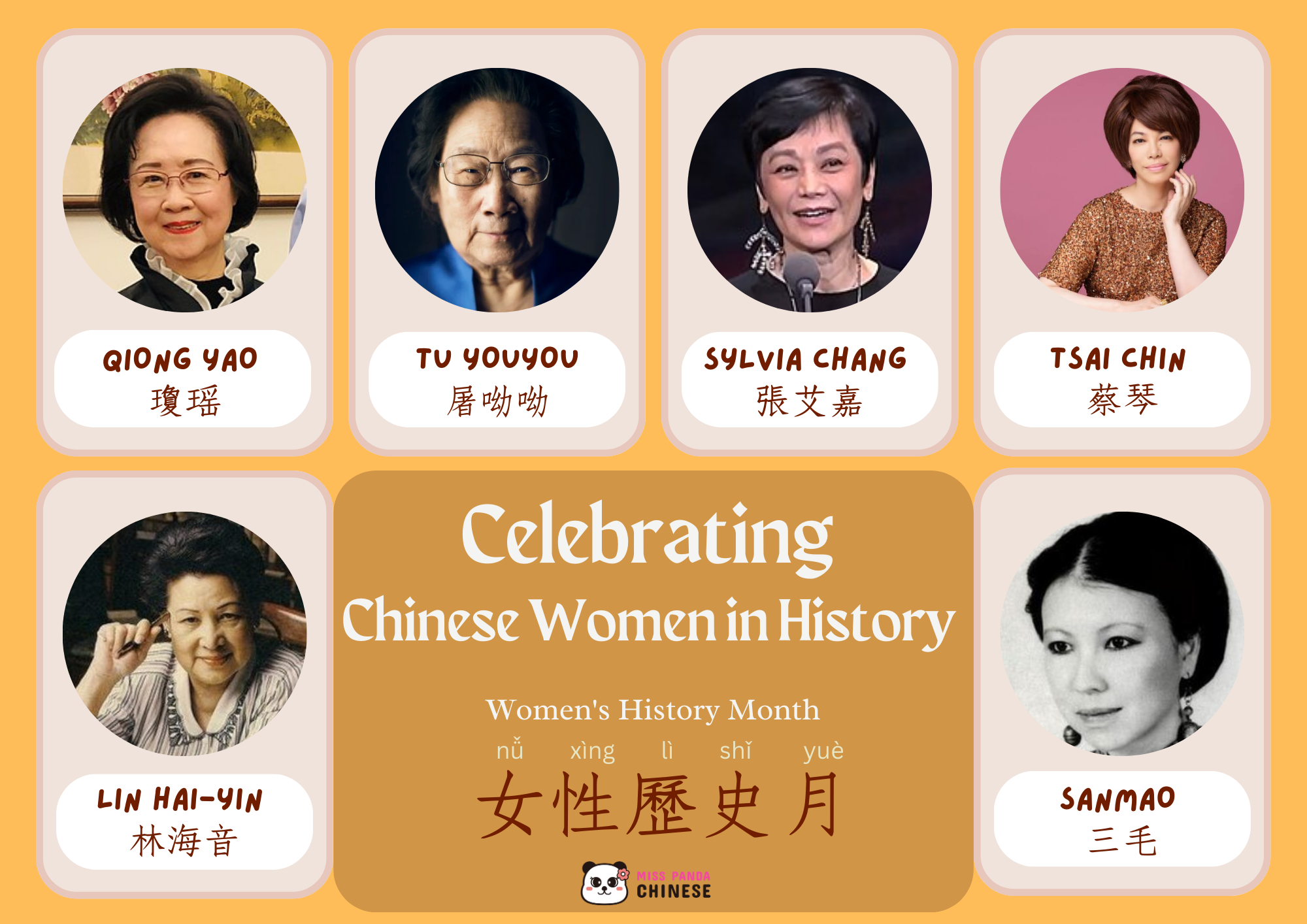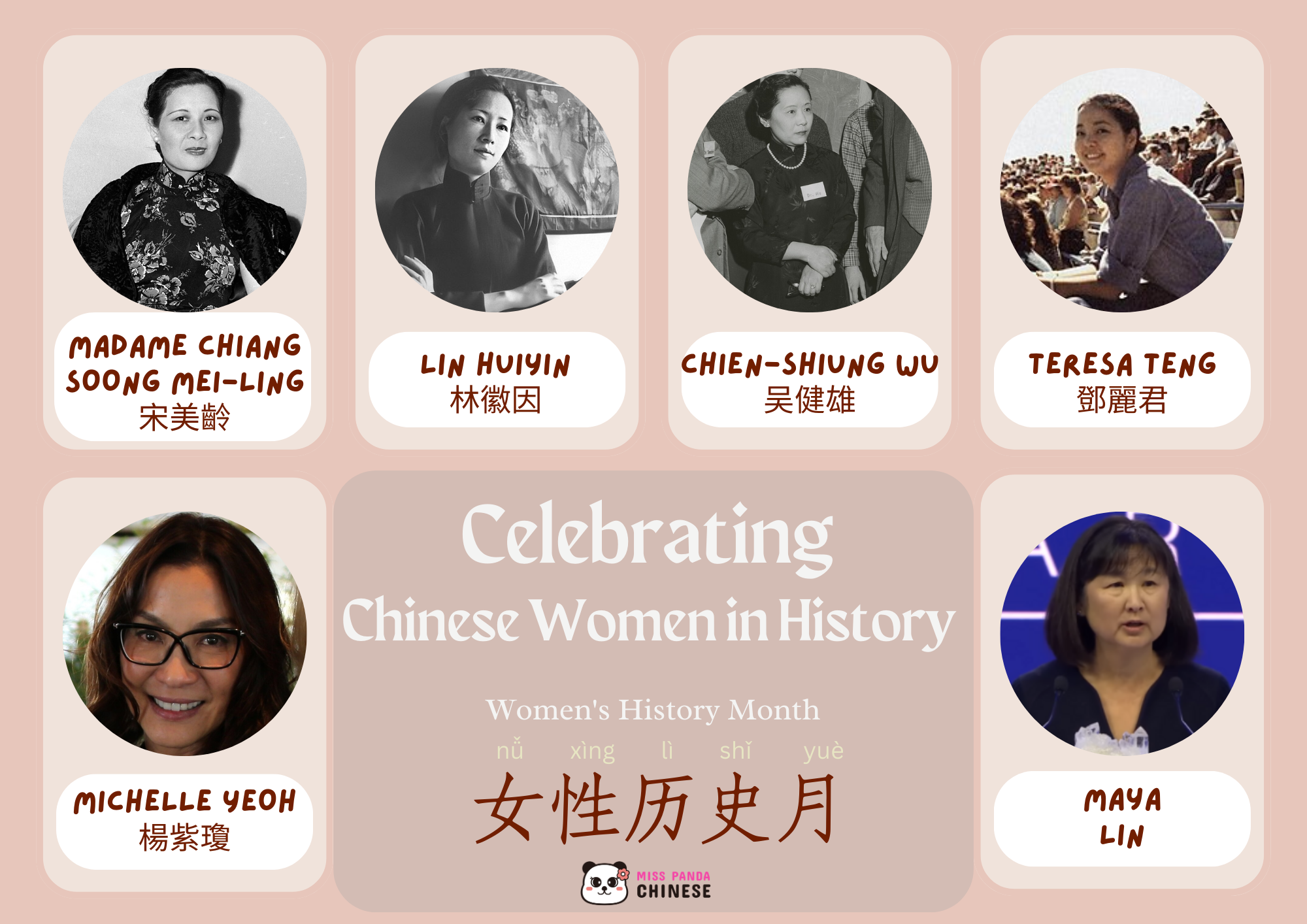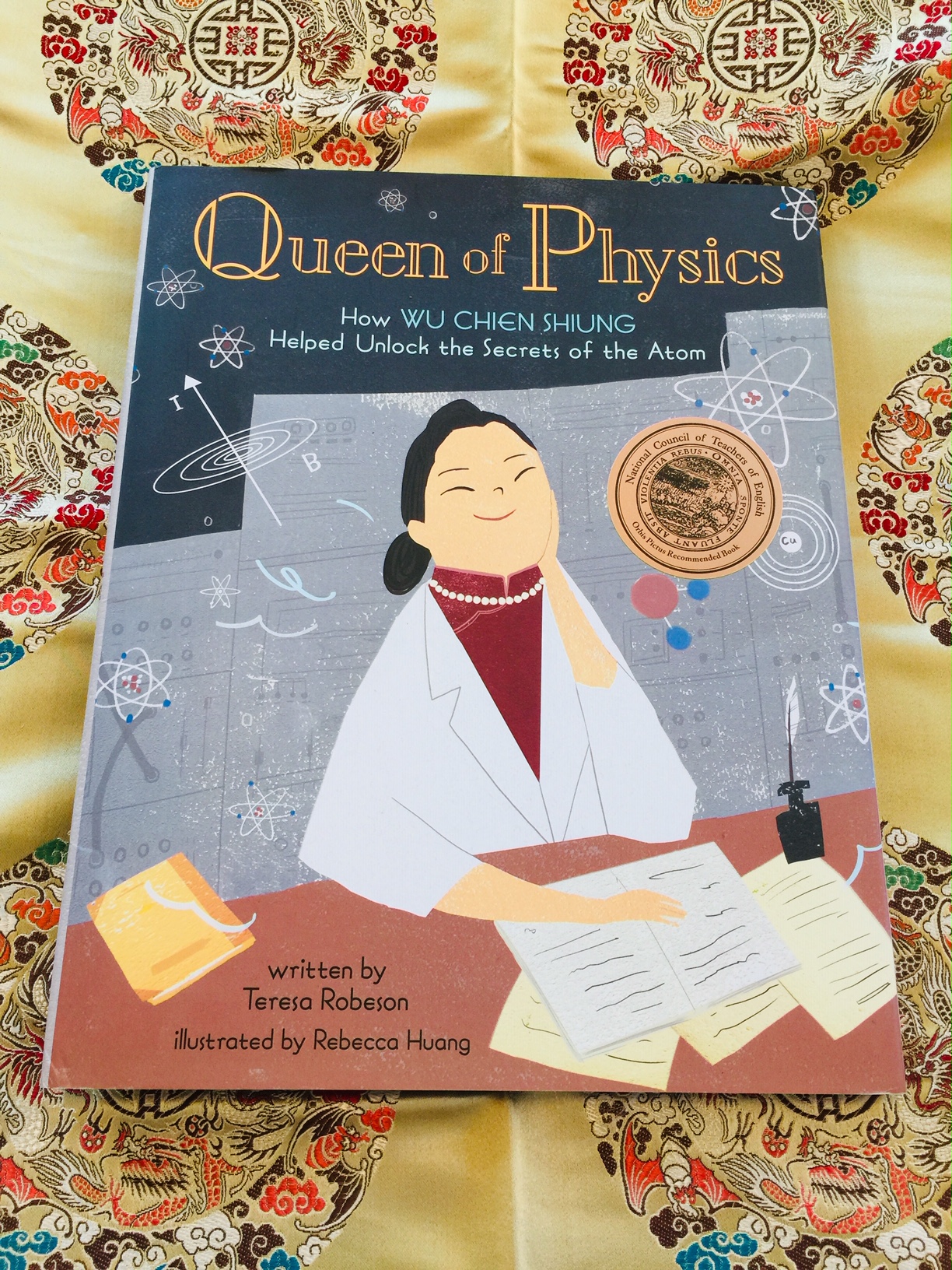Chinese women in history

In March, we celebrate Women’s History Month and International Women’s Day. It’s an opportunity to honor the achievements of Chinese women in history. Some of these female role models left an indelible mark in the world and some keep inspiring us.
From diplomatic icons to pioneering scientists to incredible artists, these change-makers have paved the way for us and future generations. Children need to know their stories of resilience, creativity, and leadership.
Here are six inspiring female Chinese figures in history. You can guide your children to connect, explore, and be curious about them. Please keep in mind that there are many more prominent female role models. Children can use this list as a starting point to make comparisons and identify the significance of the work they do.
I’ve included resources for further reading at the end.
Song Mei-ling (宋美龄) – A Diplomacy Icon
Song Mei-ling was a prominent figure in the Chinese diplomatic scene, both in China and later in Taiwan, the Republic of China. Born in 1898, she was also known as Madam Chiang Kai-shek (jiāng fú reń 蔣夫人), the first lady of the Republic of China (Taiwan). She attended Wellesley College in the United States. Beyond her political role, Song Meiling was deeply involved in social and welfare projects and played a significant role in Sino-American relations during World War II. Her eloquence, intelligence, and dedication to her country and its diplomacy make her a timeless icon of strength and leadership.
Explore TIME magazine’s Person of the Year A Photo History of 1937.
Chien-Shiung Wu (吴健雄) – The First Lady of Physics
Chien-Shiung Wu, born in 1912, was a pioneering physicist. She was known for her groundbreaking contribution to the field of nuclear physics. Her experimental work disproved the Law of Conservation of Parity, challenging established scientific principles and prompting a reevaluation of fundamental laws of nature. Wu’s resilience in a male-dominated field and her innovative research earned her the nickname “The First Lady of Physics.” She has been inspiring countless women to pursue careers in science.
Book Recommendation: “Queen of Physics: How Wu Chien Shiung Helped Unlock the Secrets of the Atom” by Teresa Robeson
Maya Lin – A Visionary in Memorial Architecture
At just 21 years old, Maya Lin designed the Vietnam Veterans Memorial in Washington, D.C. It was a testament to her vision and creativity. Lin’s design, selected from over 1,400 submissions, revolutionized the concept of memorial architecture. Her work, characterized by its simplicity and emotional depth, serves as a bridge between the past and the present, inviting reflection and healing for generations to come.
Born from her childhood fascination with space and nurtured, Maya Lin emerged as a true visionary artist-architect. You can learn from “Maya Lin: Artist-Architect of Light and Lines” by Jeanne Walker Harvey
Michelle Yeoh – A Trailblazer in Cinema
Michelle Yeoh made history by being the first Asian actor to win an Oscar for best actress. Yeoh is known for her martial arts expertise. However, she was initially trained in ballet. She started ballet at age 4. Due to an injury, she paused ballet and later pivoted to acting. Her first camera work was a commercial with Jackie Chan. Yeoh does most of her stunts. It is very impressive. Have you watched the movie, “Crouching Tiger Hidden Dragon” 臥虎藏龍• 卧虎从龙 or the recent Netflix original “The Brothers Sun” 孫家兄弟• 孙家兄弟 (rated MA – not for kids) yet?
Her Oscar-winning film, “Everything Everywhere All at Once” broke stereotypes and highlighted the representation of Asian women in the international film industry. Yeoh is multilingual, she speaks Malay, Cantonese, Mandarin, and English. Interested in learning more about Asian Americans in film?
Book Recommendation: “The Golden Screen: The Movies That Made Asian America” by Jeff Yang, a New York Times bestselling author.
Teresa Teng (邓丽君) – The Voice of Asia
Teresa Teng, commonly known as Teng Li-Chun (鄧麗君 • 邓丽君), is a beloved Chinese music and cultural icon who captivated audiences across Asia and beyond for nearly 30 years until her passing in 1995. Her enchanting voice with melodies and heartfelt lyrics resonated deeply with listeners, earning her widespread adoration. Teng’s music transcended borders, touching the hearts of people not only in Taiwan but also in Mainland China. Her songs, such as “何日今再來• 何日君再来-When Will You Come Again, and many more, served as a symbol of connection during a time of strained relations across the Taiwan Strait, fostering connections despite travel restrictions between the two regions.
The song in the video here is “月亮代表我的心 The Moon Represents My Heart.” It reached Jon Bon Jovi and here is his singing of the song in Mandarin.
Lin Huiyin (林徽因) – A Pioneer in Chinese Architecture and Literature
Lin Huiyin, born in 1904, was a remarkable architect, writer, and scholar. As one of the first female architects in modern China, Lin played a crucial role in preserving Chinese architectural heritage. Her literary works imbued with depth and sensitivity, contribute significantly to our understanding of China’s cultural and historical landscape.
Recognized as a pioneering woman who forever changed Chinese architecture, Lin Huiyin faced numerous challenges in a society where women were not treated equally. Alongside her husband Liang Sicheng (梁思成), considered the father of modern Chinese architecture, Lin overcame the limitations of their time. Together, they bridged the gap between East and West, blending traditional values with modern aspirations. Their shared mission was to inspire future architects to honor tradition while embracing innovation. (Source: Rebuilding Chinese Society Through Architecture – The Story of Lin Huiyin)
Additionally, Lin Huiyin was honored with the title “The Most Talented Woman of the Era” in a book, further recognizing her remarkable contributions to Chinese society.
Discovery & Curiosity with Kids
After exploring the brief stories of these inspirational Chinese women in history, share your thoughts:
-
What impression do you have of these iconic figures?
-
Why is it important to celebrate the diverse contributions of Chinese women in history to society?
-
Similarities and Differences: Name a couple of iconic female figures in where you are or in the U.S. who have similar contributions to society.
-
Learn about the background of International Women’s Day with the United Nations.
-
Explore the Women’s History Month (Chinese) and more (English)
What do people say…
On March 8, International Women’s Day – in Chinese, it is called ” fùnǚ jié 婦女節 • 妇女节.” You will hear people use this greeting in Mandarin: sān bā fùnǚ jié kuài lè 三八婦女節快樂 • 三八妇女节快乐. This greeting’s literal translation in English is “Happy Third Eight Female Day.” Can you figure out why?
After I shared the first part of the post, I received recommendations. So, here is another round of amazing Chinese and Taiwanese female role models.

Tu Youyou (屠呦呦): The Scientist Who Saved Millions
Imagine a world where a simple mosquito bite could lead to a deadly illness.
This was the reality before Tu Youyou (屠呦呦), a brilliant scientist from China, stepped in. Born in China, Tu Youyou dedicated her life to finding a cure for malaria as part of “Project 523”. She dove into ancient Chinese medical texts, including Ge Hong’s Handbook of Prescriptions for Emergencies, searching for clues, and discovered the power of artemisinin from sweet wormwood. She even tested the drug on herself to ensure it was safe! Her relentless pursuit led to artemisinin, a breakthrough that has saved millions of lives worldwide. In 2015, she was awarded the Nobel Prize in Physiology or Medicine, a shining example of how curiosity, dedication, and a passion for knowledge can change the world.
Sylvia Chang (張艾嘉): The Multitasking Movie Maestro
Lights, camera, action! Meet Sylvia Chang (張艾嘉), a true force in the world of Chinese cinema.
Born in Taiwan, Sylvia’s journey began with a stint as a radio host, honing her storytelling skills. Soon, she captivated audiences as an actress in the 1970s and 1980s, but she didn’t stop there. Sylvia transitioned to directing, with notable films such as Once Upon a Time (1981), 20 30 40 (2004), Murmur of the Hearts (2015), Love Education (2017), and A Light Never Goes Out (2023) creating powerful and nuanced roles for women in her films. She’s not just an actress or a director; she’s often both, and sometimes even the screenwriter too! Her talent and dedication have earned her multiple Golden Horse Awards and Hong Kong Film Awards. Sylvia actively encourages and mentors younger filmmakers through film workshops and festival programs, ensuring her passion and knowledge continue to inspire future generations.
Tsai Chin (蔡琴): The Voice That Bridges Generations
Close your eyes and imagine a voice that is both warm and powerful, a voice that tells stories and touches your heart.
That’s the voice of Tsai Chin (蔡琴), a beloved singer from Taiwan. Born on December 22, 1957, in Kaohsiung, Taiwan, Tsai Chin debuted in the late 1970s and has captivated audiences with her distinctive alto voice and emotive style ever since. Her classic hits, like “The Forgotten Time”, are sung in both Mandarin and Taiwanese Hokkien, preserving cultural heritage and resonating with listeners of all ages. Through decades of sold-out concerts and charitable work, Tsai Chin has shown resilience in the face of personal struggles, artistic reinvention, and the importance of giving back to the community.
Qiong Yao (瓊瑤): The Queen of Romance
Step into a world of love, drama, and heartfelt emotions with Qiong Yao (瓊瑤), the author who shaped generations’ understanding of romance in the Chinese-speaking world and beyond.
Born in Chengdu, Sichuan Province, China, Qiong Yao began writing stories in her teens, finding solace and expression through her words. Her novels, filled with passionate characters and intricate plots, became cultural phenomena. Her works were adapted into countless popular TV dramas and films like “Romance in the Rain” (煙雨濛濛) and “My Fair Princess” (還珠格格). Qiong Yao’s storytelling sparked a love for reading, particularly among young women, and launched the careers of many famous actors and actresses.
Saying goodbye: Qiong Yao departed the world late 2024, however, the stories she wrote will stay for generations to come.
Sanmao (三毛): The Free-Spirited Traveler
Pack your bags and be ready for an adventure with Sanmao (三毛), a writer who inspired a generation to explore the world.
Sanmao’s life took her from China to Taiwan. Later, she headed to the Sahara Desert. Her book, “Stories of the Sahara” (撒哈拉的故事), captured her experiences living in the desert with her Spanish husband, sharing tales of love, freedom, and self-discovery. Sanmao’s candid reflections and adventurous spirit encouraged young people, especially women, to break free from convention, embrace independent travel, and seek their paths.
Fun Fact: I loved all Sanmao’s books. I used to stay up late to read and re-read her books when I lived in Taiwan. I am only one of the millions of her fans.
Lin Hai-yin (林海音): A Literary Bridge Between Cultures
Journey back in time to old Beijing through the eyes of Lin Hai-yin (林海音), a writer who captured the essence of a bygone era.
Born in Osaka, Japan, and raised primarily in Beijing, Lin Hai-yin relocated to Taiwan in 1948, where she became a prominent editor and literary figure. Her most famous work, “My Memories of Old Beijing” (城南舊事, published in 1960), is a semi-autobiographical novel that offers an intimate portrait of her childhood in the 1920s and 1930s. Lin Hai-yin’s stories bridge cultures, connecting Mainland and Taiwanese readership, and through her editorial roles, she nurtured new writers, leaving a lasting impact on modern Taiwanese literature.
Fun Fact: I did a radio drama of “My Memories of Old Beijing” with a group of friends at a college radio station many years ago.
Who do you have in mind? Who else should I include in the next update? I am looking forward to hearing from you.

2025 update



Very interesting and informative, keep up the good work
and informative, keep up the good work 

